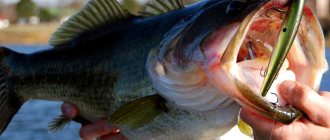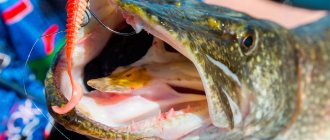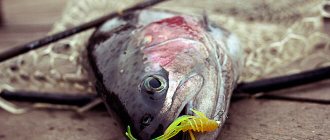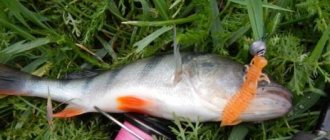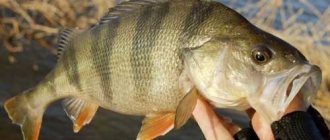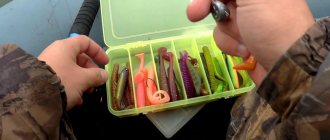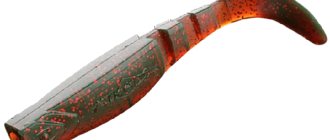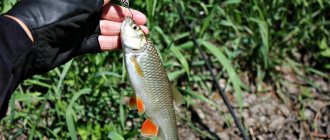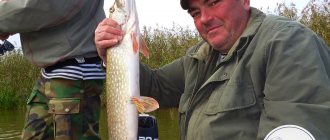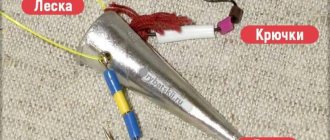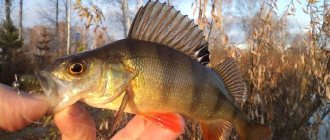There are avid wobblers, iron workers, silicone workers and generalists - it’s impossible to single out someone, all approaches are good.
But fishing with jig baits definitely has its own characteristics, nuances and philosophy. And catching perch with a jig is characterized by excitement and a variety of silicone baits used, as well as methods of rigging the “rubber” and their presentation.
Depending on the size and mood of the fish, fishing conditions and the baits used, the spinning technique for catching striped robber with silicone can differ radically. Let's go through the basics, without which successful fishing can only be accidental.
Gear used
When choosing and collecting jig gear, as well as when choosing baits and methods of equipping them, it is worth considering that there are two types of perch - the weed grass perch (perch up to 100-120 grams), which lives in almost any puddle, and also the larger , which grows into solitary humpback whales. Spinning of both species is carried out differently, due to differences in their habits - from searching for fish to choosing baits and the method of presenting them. The technique, search tactics and strategy for catching promising places differ.
In this article we will focus on large perch as a more interesting opponent. Let’s talk briefly about the grass fish, and catching it is disproportionately easier even for an inexperienced fisherman.
Ultralight “sports” tackle for okushat
For targeted catching of small perch (and at the same time peaceful fish), a fast-action rod with a weight in the region of 1-5, 2-7 grams is suitable. Good with a sensitive glued tip to feel the bottom and the smallest bait when retrieving. A high-quality headset is a must, otherwise thin cords will quickly become unusable, plus the casting range will suffer.
Shimano reel 800-1000. With high-quality line guide and other elements. The meat grinder should not throw off the loops. Riobi, Shimano, Daiva reels meet these requirements.
The thinnest and slipperiest cords (0.06-0.1), monofilament (0.1-0.2), and fluorocarbon (0.1-0.16) are used.
Tackle for perch “250+ grams”
It is worth considering that even large perch only rarely grow over a kilogram or more, so the tackle should be of the middle class, not very heavy and powerful.
A fast form with 5-21 grams of dough is a universal form. Allows you to use almost all perch silicone and work with the necessary loads at depths of up to 4-6 meters.
Meat grinder 2000-2500 according to Shimano with high-quality cord laying. It is better to use braid with a diameter of 0.1-0.15. Monoline at great depths, where medium and large perch often stay, is not so responsive because it stretches.
Equipment for jig baits for perch
There are two main types of equipment for jig baits - articulated on a Cheburashka and blind on a jig head. The first option on Ushastika is more popular for a number of reasons:
- The bait has greater mobility on a Cheburashka than on a rigid fixation with a jig head. This gives the rubber additional attractiveness when wiring; a vibrating tail or twister plays very well on such equipment in both the horizontal and vertical components.
- Versatility and interchangeability . Modern Cheburashkas can be easily and quickly changed by setting them to the desired weight and shape, without changing the bait itself.
- The floating rubber on the Cheburashka at the bottom takes the pose of a feeding fish, which additionally provokes an attack.
- Can be used as a hook - offset hooks, doubles and tees, single hooks with a wide eye.
There is such a truth - the lighter the weight of the load, the better the bait plays on the jig head; the larger it becomes, the better the play on the articulated hitch.
Hinged mounting of vibrating tails on eared sinkers of various shapes - on a double to reduce the number of derailments and on offsets for snags
Hard installation
Exploded snap-ins
When fishing for perch with silicone, spaced rigs are used in cases where conventional ones are not effective, or their use is simply impossible. Since there are quite a lot of such equipment, we will consider the purposes and features of their use in detail in the following articles, but now briefly and to the point for a general understanding:
Drop shot
An interesting rigging option in which the bait and load are spaced apart, but on the same vertical. It is good to use passive bottom perch in the wiring variant: pulling the load along the bottom - animation with the bait almost in one place - pause with attenuation - repeat the stage.
Texas rig for bass
Texas is used in strong, snarled areas. A variation of the rig on an offset hook, only a bullet weight is used.
Carolina rig for bass
A variation of the Texas one, but with spaced-out loads and bait. For fishing in difficult conditions and for passive fish near the bottom.
Jig-rig (Tokyo-rig in Japan, Chupa Chups rig in the CIS) for perch
Relatively new equipment in the CIS and Russia. It differs from mounting on an eared one in that an additional component is added to the game when falling and when hitting the bottom. What is important for passive fish.
Retractable leash
It makes sense to use it when fishing at great depths and it is necessary to use a heavy load, which, if directly coupled, will completely deprive the bait of play.
When rigging, it is extremely important to maintain a “bait-weight” balance, otherwise the silicone will simply stop playing, this is especially true for active baits.
Jig
It all started a long time ago with a rig with a dead fish, which later in Europe began to be called the “Drashkovich rig.” And then a “reusable live bait” was invented - a vibrotail. Since the traditional wiring for dead fish was alternating stretches and pauses, they began to work with silicone in the same way, and this gave positive results. At the same time, two styles of jig fishing were born and continue to exist - Russian and American. The difference between them is that in the American version, wiring is carried out with a rod, and in the Russian version, with a reel. Each of them has its own disadvantages. So, in Russian jig it is necessary to clearly fix the tip of the spinning rod in one position. This is sometimes difficult to do, especially in the wind. In the American style there are more disadvantages - the moment between the end of the active retrieve and touching the bottom is practically uncontrollable, because at this time the slack is exhausted. But what both styles have in common are mounting options, of which there are only two: • The first - classic - is fixing the bait on a rigid jig head. • The second, newer and more popular is hinged mounting. Mounting on a jig head has more disadvantages than advantages. Firstly, it is impossible to vary the weights. In addition, very often there is a clear pattern when the size of the hook is almost directly proportional to the weight of the load. And what should we do when we catch pike with large rubber, but the conditions are such that loads of more than three grams are too large? Secondly, all other things being equal, the number of trips with a jig head is significantly greater. This could be from a low-quality hook, damaged by overheated lead, or from a lever that creates straightness in the structure. In addition, the jig head flies worse. And with hinged mounting everything is very simplified. Roughly speaking, you can take one single bait, equip it with a hook of a suitable size, shape and quality, and collect a lot of Cheburashkas of different weights.
How to catch perch on a jig: find and not miss
It is important to find a perch, especially in a new water area, and know exactly how to present it with bait. What to do if there are no boilers on the surface, and fishing takes place in a new, unexplored place?
In new vast water areas, when catching perch from the shore, we use a fan technology, in which we divide the fishing sector into equal 10 parts and make 2-3 casts into each of them at different fishing horizons (bottom, bottom, half-water) in search of active fish . Then, if this method does not give the desired result, we begin fishing in promising places - dumps and depth changes, edges, any spots on the bottom, snag debris.
Animation is a very important point when catching sailors, especially moderate ones. There are quite a few wires used, but the most effective ones for perch are the following:
- Uniform . Standard, used for actively playing vibrotails, twisters, some crustaceans and octopuses.
- Wavy . It is carried out either at the bottom or in the water column. The wave is created by smooth acceleration/deceleration of the rotation of the coil. You can finely twitch the bait with the tip of the rod - it won’t get any worse.
- Trembling . Perch loves small-amplitude bait action, and therefore this type of animation is quite effective. It infuriates even a passive, sluggish predator. Trembling is caused by small and frequent twitches of the rod tip.
- Pulling bait with a spinning rod . The detonation with a reel or spinning rod is sharp, but not very amplitude, and then a smooth pull up with the rod - the bait moves slowly and at the same time falls, as if duplicating the bottom of the reservoir, hovering above it.
- Classic jig step . 1-3 turns of the reel - pause - 1-3 turns of the reel - pause, most often with the bait falling to the bottom. We use smooth, sharp turns and variations on the theme.
- Dragging along the bottom with pauses . The bait, most often passive, drags along the bottom with rising turbidity. Pauses are required. For a passive predator, that’s it.
- Double and triple tosses . Throws are made with the rod one after another, at this time the slack is removed with the reel. For this kind of animation it is better to use articulated equipment. The variability of this type of animation is both a plus and a minus. You can vary the number and strength of blasts, the pause between them, as well as the speed of removing the slack in the cord.
- Single toss . Variation of the previous one. Somewhat similar to wave-like, but sharper at the end and start points of one animation interval.
Spring
In spring, the water is still cold and the fish are rather lethargic. At this time of year, lazy animations are used, without sudden movements. Quite long pauses, up to a minute or more, are often effective.
Jig baits of 1.5-3 inches are used. Passive worms/slugs with a strong smell and taste of salt/garlic are good.
On floodplains and floodplains, you should look for perch in the middle layers and near the bottom.
On rivers we use spaced rigs, jigs with eared rigs and soldered rigs. We search at depth near the bottom, along steep banks on dumps, among snags. Drop shot, Carolina and Texas are very effective at this time.
Summer
In the warm season, perch is angry and active, but in any case it is not always easy to find it, much less catch it.
In summer, perch is better caught with active jig baits, which imitate small fish of various types, or with passive ones, but with animation actively set by the angler. The size is also larger than in spring - silicone of 2.5-4 inches works better and additionally cuts off small things.
Variations of animation - all listed and their variants, based on fishing conditions.
It is a well-known fact that the smaller the perch, the more numerous schools it gathers, and vice versa. Therefore, there is no point in looking for decent perch in boilers.
Autumn
Perch fishing in early autumn (September-mid) is carried out using medium and large jig silicone baits. At this time, he is still quite actively taking active baits such as vibrating hosts, twisters, and various cuttlefish.
You should look for this handsome fish in holes, deep off the coast, in snags, on slow rivers and lakes at any difference in depth.
Spaced rigs, Cheburashka rigs and regular jig heads are used. The size is from 2 to 4-5 inches, depending on the depth, the size of the intended prey, and the strength of the current. Wiring - steps, explosions and their variations, wavy.
In late autumn, when the water gets colder, passive worms and slugs work better. Retrieving is slow at the bottom, dragging along the bottom with pauses. Size 1.5-3 inches.
The rule is simple (theoretically) - in cold water we use slow retrieves with passive baits for perch. On the warm side - high-frequency animations with active and/or passive baits.
In spinning fishing, every detail is important - correctly assembling the tackle, skillfully selecting the bait and presenting it to the perch, finding the resting place of this same perch and tempting it to attack. This all comes with experience, and any recommendations, including ours, will only allow you to make fewer mistakes when purchasing it.
Fishing with silicone near the surface
PLACE AND TIME WHERE IT WORKS
The objects of fishing in this topic will be only two types of fish, but they occupy the lion's share of the interest of anglers. Our most “native” predators—perch and pike—very often never cease to amaze with their tastes and actions, sometimes perplexing the fisherman. Fishing with silicone in the near-surface layer on small rivers with background depths of up to 2-3 meters and snags can seriously save your costs associated with endless cliffs. I note that this is often no less effective. If we are talking about fishing from a boat, then wobblers are perhaps more preferable. If from the shore, it is not so obvious. Silicone, firmly rooted and permanently settled both in the minds and in the boxes of most fishermen, has become almost synonymous with the word “jig.” Jig fishing almost always involves fishing near the bottom, most often touching it. This is perhaps the most common and justified use of silicone. In the same article we will talk about fishing with silicone closer to the surface of the water. The best time for such activities is from May to September. Right now, the fish are trying as much as possible to use coastal algae for their ambushes. In addition, active predators, especially pike, often take up positions at mid-water. Obviously, this is due to the desire for maximum control of the entire horizon. At a depth of even four meters, the bait at the surface will be very noticeable. In large but shallow bays, aquatic vegetation grows wildly in warm weather. Therefore, bottom fishing methods become ineffective. And often wobblers with their tees catch algae from the first meters of wiring. The use of different “hardware” with protective mustaches often does not lead to the desired result. As for jig, numerous pike and schools of perch do not deprive the angler of attention, delighting with bites. It has happened more than once that, having proven wobblers in your arsenal, you had to switch to jigs due to a banal lack of attention to a promising place. And only there the bites occurred.
FISHING GEAR
The usual subsections of many articles on gear and wiring are combined here to emphasize the simplicity and minimal differences from bottom jigging. For me the main difference is the weight of the jig head. If there is no particular need to make long, targeted casts, then it is better to use a smaller load, and the bait itself is a little larger and more persistent. This is all done to simply increase the time of free fall, during which the largest number of bites occur. Among the montages, the “horse head” has proven itself well, and has been described quite fully and skillfully more than once. Twisters with a voluminous body are also good in this regard. Moreover, they are ready to forgive the wrong combination of cargo and bait. In general, I fish with the same rigs that gave bites at the bottom and did not remain on the snags of the Donets and other rivers. As it has already become clear, we won’t trifle with the size, since we are counting on an active predator, but we will pay more attention to the color of the bait. Most likely, the predator will see the bait against the sky; moreover, at shallow depths, sunlight will help the fish more clearly determine what is being offered to it. As for the bait itself, you will have to select it every time, but you can take care of the leash and the thickness of the cord in advance by choosing the most camouflage option. Perhaps this will help persuade one or two additional “tails” that are neutrally inclined to bite to bite. This often makes a huge difference. The usual stepped wiring in the upper layer of water, in my opinion, is most effective in most cases. I have seen more than once how fish were also caught by evenly moving nondescript silicone baits. But for me, this is a stage long past and I don’t engage in combing the reservoir by horizontally dragging a jig near the surface. All your own “signature” jerks and pauses that tempted the predator to bite at the bottom should also work at the surface. I would like to note that a skillfully presented bait costs a hungry predator nothing to rise from the depths a couple of meters.
CATCHING PIKE AT THE SURFACE
The main deep channel, bordering a ridge of coastal water lilies, is associated, first of all, with pike. It is here, during the season of maximum growth of algae, that pike can be seen among the water lilies through polarizing filters. Perhaps, successfully running a wobbler along the thickets would also be a worthy solution, but I would not rush to say definitively which method will give the best result. In small rivers, most pike individuals, if not all, can be considered “grass fish”. Without pretending to catch “crocodiles” in such places, I will keep in mind spotted ones up to two kilograms. Rafting down the river in one large boat with two of our comrades, we sometimes made casts to one point. Moreover, they fished with the most common rubber from Mann's and Relax, while I only fished with wobblers, which had worked well for pike that summer. So, there were at least six pike bites (either caught or cuts left on the bait).
At the same time, only one of them fell to my lot, which ultimately brought victory over the “kilushka”. Fortunately, two chubs and an ide caught helped to avoid a fiasco. Several recent fishing trips on a small river once again confirmed the right to exist of this theory. Over the course of two trips, we spent a lot of time on wobblers. Basically, these were cranks, moreover, from famous manufacturers and, most importantly, they had previously brought results more than once. But with silicone, we still caught a little more. But not eight times! And the final score that time turned out to be 8:0 in favor of silicone - for three of us in two days we caught eight pikes, and only with silicone. Moreover, they fished mainly in short steps near the surface, deeper there were solid thickets, very rarely there was a chance to perform normal jigging at the bottom.
CATCHING PERCH AT THE SURFACE
For me, practically all perch reservoirs with the presence of algae on the bottom become interesting only in terms of placing baits in the water column. Are there many places where in summer most of the mirror is overgrown? Probably the majority. And with the frequent proximity of overgrown and clean parts of the reservoir, the perch will most likely choose the overgrown one as the most attractive from the point of view of the availability of food and safety. Very often we are talking about high-speed fishing for small and medium-sized perch. In this context, every extra second that it took for the bait to reach the bottom, and then a damaged wiring due to hanging algae, turns into an unjustified loss of time, which will ultimately affect the result. In normal weather and the correct actions of the angler, small perch bite quite well, preventing the bait from sinking deeply. And flocks of them often stay at half-water. Let us also recall such a concept as “superficial combat.” Even if it is not as widespread as it is described in foreign literature, even if flocks of seagulls are unlikely to suggest the place of battle and exit of an active predator. But a silicone twister that comes into view in time rarely goes unnoticed. Personally, if I notice even a single “champ” at the surface, I certainly unwind the tackle and cast to that place. Very often this leads to an immediate bite. Perch is also good because it is quite easy to collect statistics on catchable baits and baits. If he is “in appetite”, then increasing the weight of the load is very justified. The advantages of fast wiring result in the ability to “pull” the flock towards you. We make each subsequent cast closer to the place from which it is most convenient to fish (most often, this is right next to the boat). If you wait until the bait reaches the bottom, or even worse, collects algae, then you can safely assume that you have missed the school or are catching the most active ones. To be fair, we also note places where silicone on the surface is far from the optimal option. Deep lakes and ponds with a clay bottom, dams with their concrete slabs, channel edges - when fishing from a boat, bottom snags, and just hunting for trophy specimens will certainly require bottom decisions from the fisherman, both in fishing and in selection bait
SUMMARY - CAUTION
As befits any intellectual and exciting activity, templates and developments “for all occasions” rarely lead to success - it is better to leave them at home. Every fishing trip has its own highlight. It is worth remembering that the bait or fish does not have to be at the bottom. As for perch, for me, in general, the main rule is to check for its presence in the water column. Pike are not so prone to biting at the surface, but sometimes they only bite there. In addition, it is short and easy to check all water horizons at each new place with several casts. In the end, with the first bites everything will quickly become clear and fall into place. Using the described method you can often achieve excellent results. This is doubly relevant and evident during competitions, which are one of the most reliable sources of information about the tastes and behavior of fish. It is there that many little things and details come to the fore. And in order not to be left out of fishing happiness, do not forget to try surface fishing with silicone baits at the right time and place.
